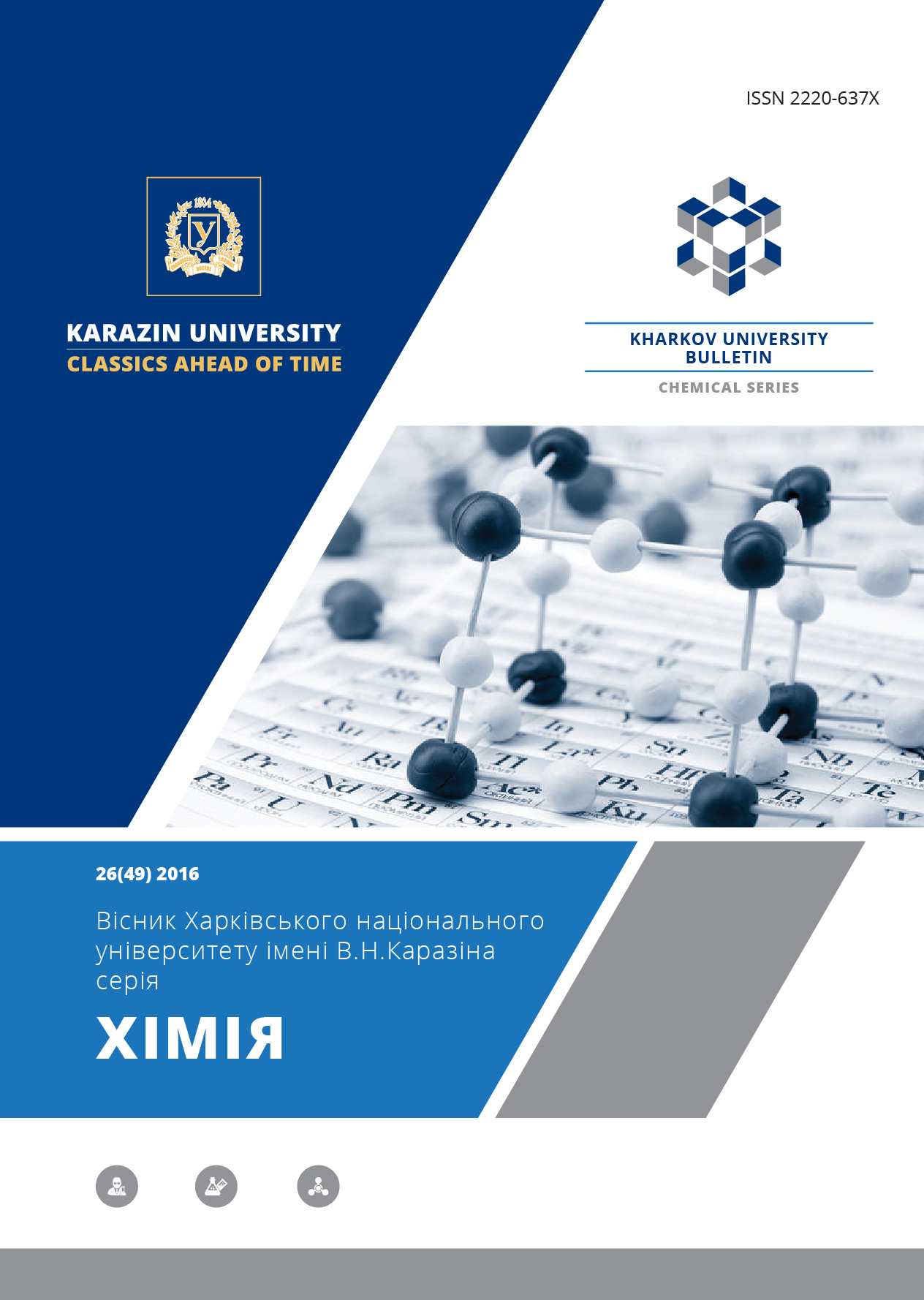A set of fluorescent probes to study the influence of low molecular weight cryoprotectants on human erythrocyte membranes
Abstract
A set of fluorescent probes, which consists of 2-(2'-OH-phenyl)-5-phenyl-1,3-oxazole, 2-(2'-OH-phenyl)-5-(4'-phenyl-phenyl)-1,3-oxazole and 2-(2'-OH-phenyl)-9,10-phenantr-1,3-oxazole, has been suggested to study the influence of low molecular weight cryoprotectants, such as glycerol, dimethylsulfoxide and 1,2‑propanediol, on human erythrocyte membranes. Using a set of fluorophores with different locations in lipid bilayer enabled to show that under the action of the cryoprotectants the increase in the membrane hydration occurs in polar regions of the erythrocyte membrane, while no changes in hydration have been observed in the most hydrophobic regions of the erythrocyte lipid bilayer. The minimal concentration of the cryoprotectant, which causes the perturbation of the erythrocyte membrane, has been estimated to be 0.5, 1.5 and 5.0 % vol. for glycerol, dimethylsulfoxide, and 1,2-propanediol, correspondingly. The suggested set of fluorescent probes can be used to monitor the changes of physico-chemical properties in different regions of erythrocyte lipid bilayer under the action of cryoprotectants and to determine optimal concentrations of cryoprotectants for low-temperature storage of the cells.
Downloads
References
B. J. Fuller, E. E. Benson, N. Lane, Life in the Frozen State, New York: CRC Press, 2004.
T. Arakawa, J. F. Carpenter, Y. A. Kita, J. H. Crowe, “Basis for toxicity of certain cryoprotec-tants: a hypothesis,” Cryobiology, vol. 27, iss. 4, pp. 401-415, 1990.
G. E. Dobretsov, Fluorescence Probes in Cell, Membrane and Lipoprotein Investigations, Moscow: Nauka, 1989.
M. N. Girtaud, C. Motta, D. Boucher, G. Grizard, “Membrane fluidity predicts the outcome of cryopreservation of human spermatozoa,” Human Reproduction, vol. 15, no. 10, pp. 2160 2164, 2000.
T. S. Dyubko, E. V. Onishchenko, V. G. Pivovarenko, “Influence of freezing and low molecu-lar weight cryoprotectants on microsomal membrane structure: a study by multiparametric fluorescent probe,” J. Fluorescence, vol. 16, pp. 817-823, 2006.
A. O. Doroshenko, E. A. Posokhov, V. M. Shershukov, V. G. Mitina, O. A. Ponomarev, “In-tramolecular proton-transfer reaction in an excited state in a series of ortho-hydroxy deriva-tives of 2,5-diaryloxazole,” High Energy Chemistry, vol. 31, no. 6, pp. 428-435, 1997.
A. O. Doroshenko, E. A. Posokhov, A. A. Verezubova, L. M. Ptyagina, V. T. Skripkina, V. M. Shershukov, “Radiationless deactivation of the excited phototautomer form and mo-lecular structure of ESIPT-compounds,” Photochem. Photobiol. Sci., vol. 1, pp. 92-99, 2002.
Y. O. Posokhov, “A set of fluorescent probes for determination of physical-chemical proper-ties of lipid membranes,” Patent 68871 UA - Published. 10.04.2012, Bull, no. 7 (in Ukrain-ian).
E. A. Posokhov, N. A. Abmanova, T. P. Boyko, A. O. Doroshenko, “Ortho-hydroxy deriva-tives of 2,5-diphenyl-1,3-oxazole and 2,5-diphenyl-1,3,4-oxadiazole as fluorescent probes for medical and biological research,” Kharkov University Bulletin (Chemical Series), no. 454, iss. 4(27), pp. 188-190, 1999 (in Russian).
Y. O. Posokhov, “Ortho-hydroxy derivatives of 2,5-diphenyl-1,3-оxazole and 2,5-diphenyl-1,3,4-оxadiazole as fluorescent probes for toxicological study of the cells of olfactory analyzer of rats,” Kharkov University Bulletin (Chemical Series), no. 976, iss. 20(43), pp. 92-99, 2011 (in Russian).
E. A. Posokhov, T. P. Boyko, D. A. Bevziuk, “Ortho-hydroxy derivatives of 2,5-diphenyl-1,3-оxazole and 2,5-diphenyl-1,3,4-оxadiazole as fluorescent probes for toxicological investiga-tions of model membranes,” Kharkov University Bulletin (Chemical Series), no. 532, iss. 7(30), pp. 192-194, 2001 (in Russian).
A. O. Doroshenko, E. A. Posokhov, “Proton phototransfer in a series of ortho-hydroxy deriva-tives of 2,5-diaryl-1,3-oxazole and 2,5-diaryl-1,3,4-oxadiazole in polystyrene films,” Theo-retical and Experimental Chemistry, vol. 35, iss. 6, pp. 334-337, 1999.
H. M. Shapiro, Flow Cytometry, New York: Science, 1995.
C. Ho, C. D. Stubbs, “Hydration at the membrane protein-lipid interface,” Biophysical Jour-nal, vol. 63, pp. 897-902, 1992.
C. Ho, S. J. Slater, C. D. Stubbs, “Hydration and order in lipid bilayers,” Biochemistry, vol. 34, pp. 6188-6195, 1995.
E. A. Disalvo, F. Larion, F. Martini, E. Tymczyczyn, M. Frias, “Structural and functional properties of hydration and confined water in membrane interfaces,” Biochimica et Bio-physica Acta, vol. 1778, pp. 2655-2670, 2008.
O. I. Gordiyenko, T. P. Linnik, E. O. Gordiyenko, “Erythrocyte membrane permeability for a series of diols,” Bioelectrochemistry, vol. 62, pp. 115-118, 2004.
E. V. Davydova, O. I. Gordienko, “Temperature effect on erythrocyte membrane permeability for cryoprotectants with different hydrophobicities,” Problems of Cryobiology, vol. 19, no. 3, pp. 261-272, 2009.
G. V. Kovalenko, I. F. Kovalenko, T. P. Linnik, “The mechanism of DMSO, glycerol and eth-ylene glycol transport across rat and rabbit erythrocyte membranes,” The Journal of V.N. Karazin Kharkiv National University. Series: Biology, iss. 10, no. 878, pp. 109-116, 2009 (in Russian).
H. Oldenhof, M. Gojowsky, S. Wang, S. Henke, C. Yu, K. Rohn, W. F. Wolkers, H. Sieme, “Osmotic stress and membrane phase changes during freezing of stallion sperm: mode of ac-tion of cryoprotective agents,” Biology of Reproduction, vol. 88, no. 3, pp. 1-11, January 2013.




